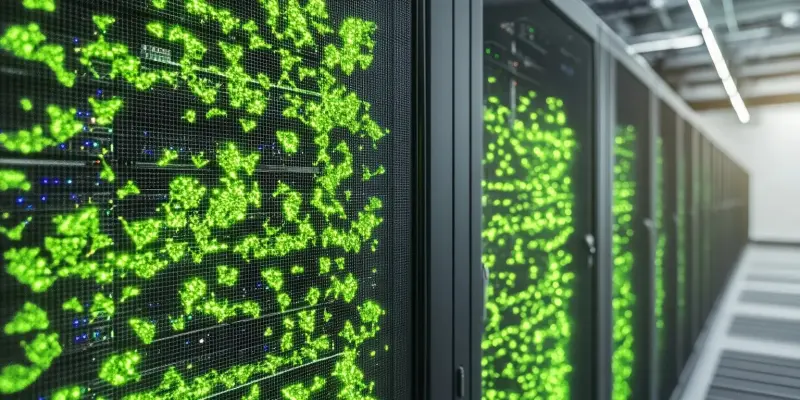With increasing concerns about climate change, the role of data centers in contributing to greenhouse gas emissions has come under scrutiny. Given that data centers and transmission networks are responsible for 1% of energy-related greenhouse gas emissions and their electricity usage is expected to double by 2026, it is imperative to explore ways to mitigate their environmental impact. This article delves into six innovative methods that data centers can employ to reduce their greenhouse gas emissions and promote sustainability without sacrificing efficiency or performance.
Apply Direct-to-Chip Liquid Cooling and Immersion Cooling
One of the primary ways data centers can cut their greenhouse gas emissions is by implementing advanced thermal management techniques such as direct-to-chip liquid cooling and immersion cooling. These approaches dissipate heat from high-performance computing systems more effectively than traditional air cooling methods. Direct-to-chip liquid cooling involves circulating a coolant directly through microchannels or cold plates attached to heat-generating components, providing a direct and efficient cooling solution.
In contrast, immersion cooling submerges servers or electronic components in a dielectric fluid that absorbs and transfers heat away. This method allows for better thermal regulation, significantly reducing the energy required for cooling and thereby lowering the carbon footprint. By adopting these advanced cooling techniques, data centers can enhance their performance while minimizing their environmental impact, making them a crucial component in the fight against climate change.
Transition to Renewable Energy and Utilize Power More Efficiently
Switching to renewable energy sources such as solar, wind, and hydropower is another effective strategy for data centers to reduce their greenhouse gas emissions. Renewable energy sources are inherently cleaner, and securing them through power purchase agreements (PPAs) can provide long-term cost stability by protecting data centers from the volatility of fossil-fuel prices. By investing in additional PPAs, which involve building new power plants, data centers can contribute to the expansion of renewable energy in the market.
Additionally, utilizing power more efficiently is crucial for lowering a data center’s overall energy consumption. A lower power usage effectiveness factor (PUE) indicates that a higher proportion of the data center’s energy is dedicated to productive computing tasks, thus reducing operational costs and the carbon footprint of the cooling infrastructure. Replacing outdated equipment with energy-efficient alternatives is one way to achieve a lower PUE, making the data center more sustainable and cost-effective in the long run.
Adopt Cleaner Fuel Sources
Data centers rely on generators to provide power during contingencies such as grid outages. Traditionally, these generators have used fossil fuels, which contribute to greenhouse gas emissions. However, emissions from these backup systems can be significantly reduced by switching to cleaner fuel sources. One such option is hydrotreated vegetable oil (HVO), a renewable diesel that emits fewer pollutants compared to conventional diesel.
By adopting cleaner fuel sources, data centers can maintain operational reliability while minimizing their environmental impact. This transition not only aligns with sustainability goals but also helps data centers meet regulatory requirements and improve their public image as environmentally responsible entities. As the industry continues to evolve, cleaner fuel adoption will play a vital role in reducing the carbon footprint of data centers worldwide.
Save Water
Water conservation is another essential aspect of reducing greenhouse gas emissions in data centers. Major water consumers in data centers are systems that cool air by evaporating water. Water efficiency improves the performance of these systems by reducing the electricity needed to run compressors in chillers, thus lowering carbon emissions. However, evaporative systems should only be installed where water supplies are sufficient and sustainable to avoid depleting local resources.
Running cooling systems in hybrid mode, where they use less water in winter and less electricity in summer, can further optimize their efficiency. This approach balances resource usage, ensuring that data centers remain sustainable year-round. By implementing water-saving measures, data centers can reduce their operational costs and environmental impact, contributing to broader efforts to combat climate change.
Reuse Heat
The heat generated by IT equipment in data centers can be repurposed rather than wasted, providing an opportunity to reduce greenhouse gas emissions. Reusing waste heat from data centers can benefit both the facility and the surrounding community. Internally, the heat can be used to warm office spaces or other parts of the data center. Externally, waste heat can be redirected to district heating systems, providing a sustainable heating solution for nearby residential or commercial buildings.
Given the long lifecycle of data centers, typically ranging from 30 to 50 years, reusing waste heat can have a significant impact on reducing greenhouse gas emissions over time. By eliminating the need for fossil fuels for heating, this practice can improve the overall environmental footprint of data centers and contribute to the sustainability of the surrounding area.
Emphasize Recycling and Disposal
With growing concerns about climate change, the environmental impact of data centers has come under close examination. Data centers and transmission networks account for approximately 1% of energy-related greenhouse gas emissions, and their electricity consumption is projected to double by 2026. It’s crucial to identify effective strategies to reduce their environmental footprint. This article examines six innovative approaches that data centers can adopt to cut down their greenhouse gas emissions and enhance sustainability. These methods are designed to maintain efficiency and performance while minimizing environmental harm. The proposed strategies include optimizing energy usage, implementing advanced cooling techniques, adopting renewable energy sources, improving hardware efficiency, and enhancing data center designs for better resource management. By adopting these practices, data centers can play a significant role in reducing their carbon footprint and contributing to global efforts to combat climate change.

